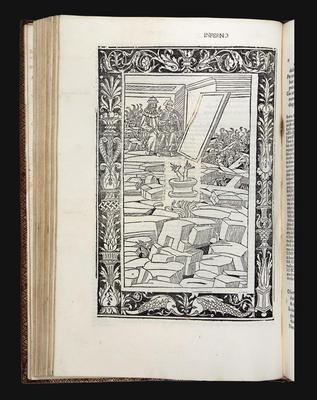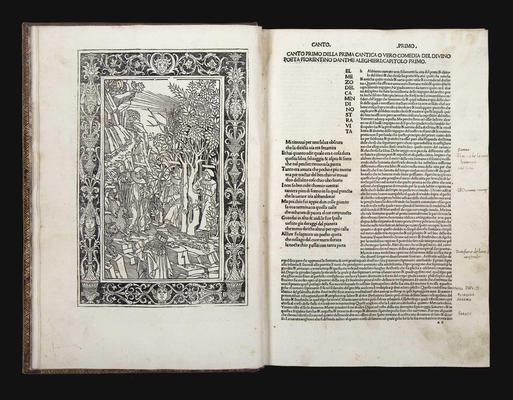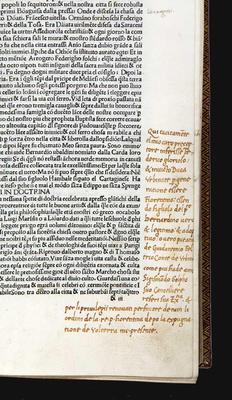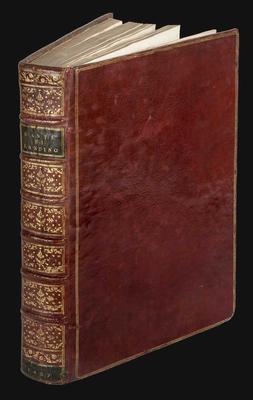Dante Alighieri
Comento di Christophoro Landino Fiorentino sopra la Comedia di Danthe Alighieri poeta Fiorentino...
Brescia, Boninus de Boninis, de Ragusia, 1487.Folio (354x238 mm). Collation: &8, a-i8, k6, l-r8, aa-mm8, nn4, A6, B8, C-L6. [309] of [310] leaves, wanting thelast blank. Text in one column, 50 lines, surrounded by commentary, 69 lines. Type: 3:111R (text), 4:81R (commentary). On the verso of fol. L5 woodcut printer's device. Blank spaces for capitals, with printed guide letters. Sixty-eight full-page woodcuts by at least two different artists (sixty blocks, eight repeats), all but one (fol. h8r) framed in one of two white-on-black candelabra borders (from two blocks). Some woodcuts with partial contemporary red colouring. Eighteenth-century red morocco, over pasteboards. Covers framed within gilt fillet border. Spine with six raised bands, with elaborate gilt tooling; title and imprint on double letteringpieces. Marbled pastedowns and flyleaves; inside dentelles. Gilt edges. A very fine wide-margined copy, slight browning and finger-marks. Numerous marginal notes and marks in different contemporary hands, including that of the earliest owner Sigismondo Golfi.
Provenance: Sigismondo Golfi dalla Pergola (fifteenth/sixteenth century), secretary to Francesco GonzagaiiMarquis of Mantua, ownership inscription in red ink on fol. L5v, partly readable under UV lamp ‘SigismondiGolphi cod [?]'); Livio Ambrogio collection.
The ‘true' first illustrated edition of the Commedia, the first containing woodcuts, the third edition to include the commentary by Cristoforo Landino. The greatest achievement of Brescian printing in the fifteenth century, in a superb wide-margined copy. The printer Boninus was born in Dalmatia; he came to Brescia between 1482-1483, and until 1491 was one of the leading printers in the Lombard city, combining excellent technical skills, a remarkable flair for typographical design, and a highly developed sense of business acumen.
The Brescia Dante – as this volume in folio is commonly known – is famous for its fine woodcuts illustrating each canto of the Inferno and the Purgatorio, and the first canto only of the Paradiso. All but one of the woodcuts are full-page, and are variously framed by two different refined candelabra white-on-black borders, displaying decorative motifs from classical antiquity. The engravings which had been executed, after Botticelli's designs, for the 1481 Florence edition clearly influenced the first woodcuts in the Brescia Commedia. The stylistic quality of the illustrations for the first cantica is particularly noteworthy: a Milanese artist trained in the school of Mantegna – especially as regards the treatment of rocks and bodies – may have been responsible, though the overall style of the woodcuts is less refined.
This copy belongs to the group with the following variants in the illustrative apparatus: in the woodcut on fol. h1r the inscription ‘anastasio papa gvardo' has been removed from the raised headstone, and placed in the centre of the cut from which the design has been excised; on fol. h8r the text has been recomposed and the woodcut depicting the wood of the Harpies does not have the border; on fol. l5v the woodcut of fol. h1r is re-used without the inscription and with an image of a round open tomb inserted in the centre.
Copies of the Brescia Dante in fine condition and with full margins, like the present copy, are rare. A further point of interest lies in this copy's contemporary provenance: it first belonged to Sigismondo Golfi, secretary and librarian at the court of Francesco Gonzaga ii(1466-1519), tutor of Isabella d'Este (1474-1539), and of her daughter Eleonora. Some marginal notes in Golfi's own hand are visible in the volume; some refer to his ‘maestro' Cristoforo Landino, suggesting that Golfi may have been Landino's pupil.





